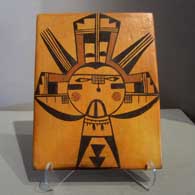Sadie Adams
1905-1995
Hopi

Sadie Adams was a Hopi-Tewa potter of the Kachina/Parrot Clan. Born in 1905 and passing on on Christmas Day, 1995, Sadie made pottery from 1930 until 1981. She lived almost her entire life in Hano on First Mesa.
Sadie was known for making yellowware jars, bowls and lamps, and redware bowls, plates, saucers, cups and cookie jars, but what she was most famous for were her tiles. Tiles are not something the Hopi would make for themselves, they are produced almost exclusively for the tourist market. Her daughter, Lorna Lomakema, recalls, "My earliest recollection of my mother and tiles was when the Coltons [Harold S. Colton and Mary-Russell Ferrell Colton] at the Museum of Northern Arizona asked her to make the tiles framing the announcement boards at the entrance."
In an interview with Dextra Quotskuyva in 1998, Dextra said, "Sadie was a really good potter. She did those ones with the flaring rims and flat ones. They're the hardest." Throughout the Pueblo pottery world it's an acknowledged fact that "flat ones" (meaning tiles) are the hardest of all pottery styles to make because they easily warp during the drying and firing phases of completion.
Sadie had a long and successful career making and selling her pottery on the Hopi reservation. Wilbur Adams, her husband, died when Lorna was only seven and Sadie supported the family solely through sales of her pottery. She even did well enough to send Lorna to nursing school. As with many Hopi-Tewa potters in those days, she sold much of her pottery through Lorenzo Hubbell's Trading Post in Ganado.
Sadie's favorite designs seem to have been clouds, feathers, thunderbirds and katsinas. Sadie's Hopi name means "Flower Girl/Woman" and she signed her pots with a five-petal peach blossom hallmark, often with a dot on each petal or with one dot in the center of the flower.
(505) 986-1234 - www.andreafisherpottery.com - All Rights Reserved
